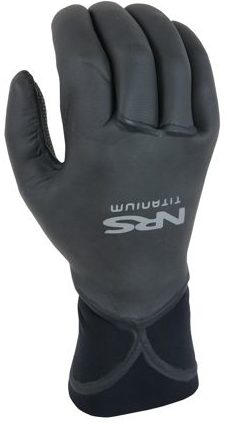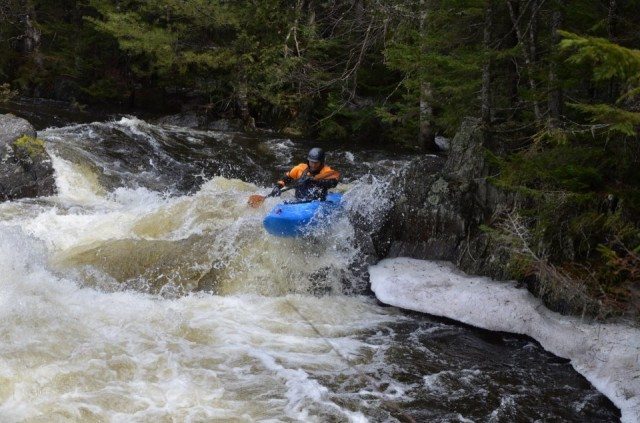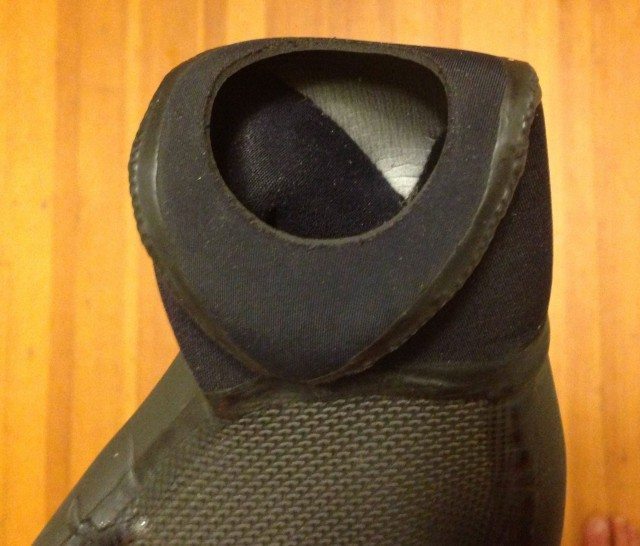
NRS Maverick Gloves with HydroCuff
Size Tested: Medium and Large
Features:
- Material: 2-mm Terraprene neoprene
- Seams: Glued & blind-stitched
- Taped Seams: Yes
- Palm Material: Textured raw neoprene
- Wrist Closure: HydroCuff
MSRP: $42.99
Reviewer Hand Size:
- Circumference around knuckles: 5.75 inches
- Wrist crease to middle fingertip: 7.5
- Circumference around wrist: 5.75
Days tested: Medium ~ 20; Large ~ 15
Locations tested: The Grand Canyon in November and January, Rivers and Creeks in Maine and New Hampshire.
I live in Maine, where the boating season starts when there’s still snow on the river banks. I wear gloves quite a bit since my hands get cold easily, but I don’t want my movements to be restricted. I picked out the Maverick because I wanted a low-profile glove that was still warm, and it seemed to fit the bill.

Mitts vs. Gloves vs. Poggies
Before settling on the Maverick, I had debated whether I wanted mitts, gloves, or poggies. This debate depends on the conditions you’re paddling in, the type of paddling you’re doing, and personal preference.
Mitts are usually warmer than gloves or poggies, but they can be cumbersome. I like to be able to zip a zipper, open a water bottle, adjust layers etc.
Poggies—neoprene sleeves attached to your paddle that you slide your hands into—give you a natural, direct grip on your paddle and keep your hands really warm. Granted, they’re only warm when your hands are in them and attached to your paddle…You might be able to wear a thin glove in combination with a poggie, but I recommend using one or the other.
I chose gloves because I thought they would be warm enough for the conditions I was paddling in and I wanted more freedom of movement.
Warmth

The Maverick, made from 2mm of Neoprene, kept my hands warm in air and water temperatures of 40-50 degrees.
I did want a warmer glove or mitt when temperatures dropped to freezing or below. Warmer gloves made with 3 and 3.5mm neoprene are available, but I lose too much dexterity with bulky gloves. I would rather have slightly chilled hands on colder days and have better paddle control.
The Maverick acts like a wetsuit. It’s not dry, and your hands will get wet, but your body heats the water around your hands and the HydroCuff keeps fresh, cold water out.
The HydroCuff fits over the tapered overcuff of my Kokotat Meridian drysuit. It goes under the velcro-secured cuffs of other dry suits or tops I’ve worn.
Sizing / Fit
The medium Maverick was snug, while the large was a bit too loose and subsequently more cold water seeped in. I would definitely recommend buying the smallest size that fits you to avoid this problem.
I also prefer tight gloves because there’s no extra material to inhibit my grip. I’ve worn gloves similar to the NRS Rapid, and they’re bulky enough that I lose some paddle feel.
A tighter glove fits almost like a second skin—I sometimes forget I’m wearing a warmer on my hand. Granted, a smaller glove is a little more difficult to put on and peel off when it’s wet, a trivial issue in my book. I’ve found the easiest way to remove the Maverick is to roll the HydroCuff down below your wrist and then pull it off.
I can easily store either size in my PFD pocket, where I can access the gloves again if temperatures drop.
Grip
I’ve used gloves in the past that supposedly have really grippy rubber, but in reality they slip on the paddle. The textured neoprene on the palm of the Maverick gives me a good grip without feeling too sticky.
The NRS Rogue glove is essentially the same as the Maverick but offers GripCote texture if you are looking for a super sticky grip.
Durability

The Maverick wears down quickly under heavy use, and they don’t stand up well to sharp rocks and ropes.
After a weekend of swiftwater rescue and rope work, the Maverick gloves had started to wear between the fingers where the rope had been.
There are small tears and scrapes in them from rocks I’ve hit while rolling or scraped in passing. These tears compromise the warmth of the glove (though only in the area that is torn / thinned). You can make pretty effective repairs to these gloves with a sealant such as Aquaseal or another glue, so I’m still using the gloves.
So if you’re going to be doing a lot of rope work or river rescue, or you’re generally hard on your hands, I would opt for a tougher glove—NRS makes the Reactor Rescue and the Classic Rescue, which cost $10-$20 more than the Maverick—for these purposes. These gloves are thicker and bulkier than the Maverick, though.
Bottom Line
The Maverick is great for those who want to keep their hands warm in above-freezing temperatures, but still want excellent dexterity. While this means sacrificing a little bit of warmth on the coldest days, I’m okay with that.
If I frequently paddled in sub-freezing temperatures, I would definitely use mitts or warmer gloves. For the type of conditions I typically paddle in, the Maverick works well. I can easily store the gloves in my PFD pocket, and they’ve proven to be a worthy cold weather second skin.
The Maverick will get beat up on rocks and ropes, so if you know you’re tough on your hands, I would recommend a thicker, more durable glove.

Hi I have quite small hands and slim wrists but I’m not sure what size to do Medium or small. Any thoughts?
Duncan, UK , Berks
Small! I wouldn’t say I have small hands (for a woman), and the small are better for me as they are a unisex glove and fit snugly for better dexterity.